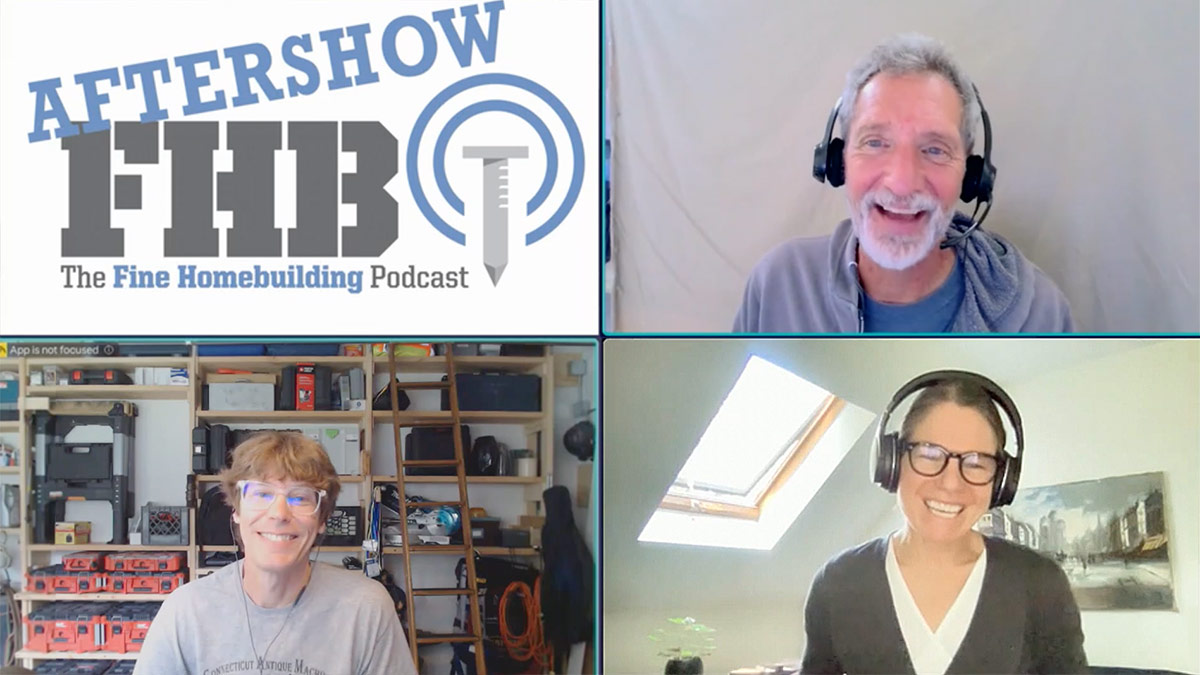Podcast 597: Fish-Mouthed Sheathing Tape, Window Installation, and Flashing a Bay Window
The crew hears from listeners about manufactured houses and DIY lighting with LEDs. Discussion questions include unstuck flashing tape, sealing the bottom of new windows, and EV chargers.
Follow the Fine Homebuilding Podcast on your favorite app. Subscribe now and don’t miss an episode:
 |
Brandon offers more info on LEDs. Walter says not to be scared of DIY. Mike Guertin explains a key difference between modular and mobile homes. Jim’s sheathing and flashing tape is not keeping out water. Mike is getting conflicting advice on taping the bottom of flanged windows. All Thumbs asks about flashing a bay window.
Editor Updates:
- Is fiberglass insulation getting less itchy?
 We’ve created a custom eLearning coupon for podcast listeners – code: PODCAST20
We’ve created a custom eLearning coupon for podcast listeners – code: PODCAST20
The Sustainable Home Building Accelerator
This intensive, interactive online series of courses is designed to rapidly advance your knowledge of sustainable home design and construction. Whether you’re an architect, builder, or a homeowner, we’ll give you the information and confidence to design and build well-crafted, practical homes that maximize performance and comfort.
Over 11 hours of video. AIA Approved 10 HSW/LU Credits. Resnet 10 PD Credits.
When you purchase all three courses, you’ll receive access to a year of GBA Prime as well as a copy of the Pretty Good House book!
Remember the code PODCAST20 for any Fine Homebuilding courses.
Listener Feedback 1:
Brandon writes:
For someone looking for LED information, I would recommend NEON dreamx.
I come from the theater industry, where I build scenery, and LED systems are very common in this world. I’ve have done several installs for closets as described in the podcast and also do my own custom undercabinet LEDs. It’s actually fairly simple if you just want one color, and, as with many custom vs. prefabricated products, you get a much higher quality finished product often for less money.
Love the show!
Brandon
Listener Feedback 2:
Walter writes:
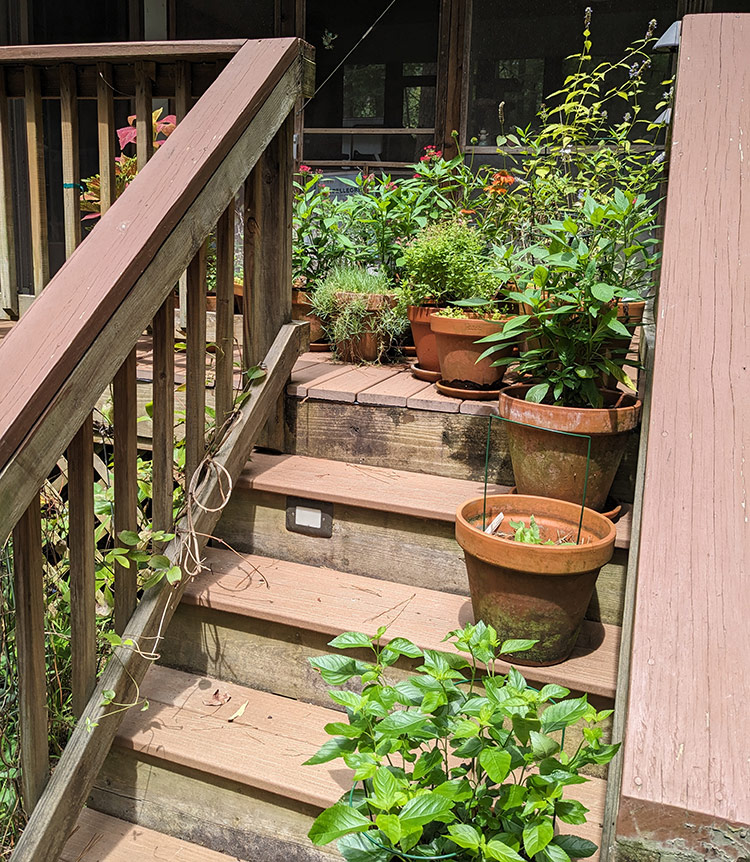
Hello again podcast cast,
I am a long-time listener and All Access member. Of the many things I’ve learned, one is that I may be the least skilled DIY person in your listening audience. Way back in Podcast #241, I asked how I could continue to put clay flower pots on my kitchen deck without continuing to rot the boards. After some discussion, you pointed me toward the extensive set of videos that the magazine had about decks. There I found that Mike Guertin now favored synthetic deck boards, and that the MoistureShield Vantage could be tricked into yielding a smooth surface if you countersunk the face screws and coaxed the shavings in over the screw. No tricky hidden connectors, no plugs. Mike’s instructions made all this look pretty simple. I have a good cordless drill, a Harbor Freight corded oscillating multitool, and a selection of hand tools. For my approximately 100-sq.-ft. project, I ordered ten 20-ft. and one 12-ft. boards, 3 lbs. of #7 2.25-in. stainless screws (as spec’d by Vantage), and a roll of butyl tape. The North Carolina summer sun only permitted working on the deck for about 5 hours a day, but I eventually had a new 8×10 deck surface and new tread on the 5 steps, all now covered in clay pots. Nothing is going to rot. Discounting my 45-50 hours of labor to the customary Fine Homebuilding DIY rate of $0, the cost was $917. I guess the moral of the story is that if you pick a reasonable project, take your time, and follow Mike’s directions, it should turn out fine, even if you aren’t too skilled to begin with. I’m glad you make stuff that even the non-tradespeople can follow.
Related Links:
- Considering Choices for Synthetic Decking
- PVC Decking with Real-Wood Look
- How to Install Composite Decking
Listener Feedback 3:
Mike Guertin writes:
Hi Patrick,
You briefly discussed the difference between modular and manufactured (mobile home) construction with Mark and Brian in Podcast 591.
I don’t think you covered how the main differences are in the way codes work regarding both. You may already know this, but it didn’t come up to differentiate the two in the discussion.
The big difference between manufactured homes and modular homes is which code they follow when constructed and any local building department oversight.
Manufactured (mobile homes) are built according to federal HUD code. Those codes have changed over the years. A long time ago, the floor frames had to be the “trailer” that carried them to the site with axles and tires attached. The axles had to remain. Changes now allow the axles to be removed, but the floor framing is still acts as the trailer frame. Local jurisdictions are generally not allowed to prohibit them from being used as housing through zoning or building codes. The only thing the local building department gets to inspect/approve is how the house is anchored to the earth to prevent wind or seismic damage if required by local building code, plumbing and electrical connections, and stairways/landings that are attached to the house. The homes are inspected and certified that they meet HUD code.
Modular homes are built to the same code as adopted by the state, county, or local jurisdiction where they will be installed. In RI, for instance, our state code is based on the 2018 IRC with about 40 amendments. Modular homes entering the state have to be built to comply with those amendments. The manufacturer has ICC-approved third-party inspectors who review the design and conduct inspections based on the RI code. The inspection report is submitted to the local official in RI, who must (by state law) accept the third-party inspection report. The local officials have to inspect the construction of the foundation (generally modular homes sit on crawlspace or full basement-depth foundations), plumbing connections to sewer/septic, electrical connections, marriage wall attachment, stacked module attachment, finish roofing, finish siding, and any other finishes that are done on site (exterior stairs/landings, decks, HVAC install – think heat pump outdoor unit, etc.)
HUD-code homes have been becoming more similar to modular homes. They used to be limited to one story, but now I think they can be stacked. I haven’t read the HUD code in a while to see what other differences there are.
Related Links:
- Manufactured Housing Institute
- GBA.com: Offsite Construction and High-Performance Homes
- Prefab Homes
Question 1: Will ZIP taping details lead to water intrusion?
Jim on GBA writes:
Hey FHB podcast,
We’re at the “dried in” phase of our project (CZ 6, NH) and getting ready for insulation (CCSF roof and DP FG walls). We’re still waiting for the standing-seam roof and siding to be installed. The ZIP roof sheathing and ZIP R9 wall sheathing are all taped. The roof has Protecto Wrap HT underlayment over the top as well.
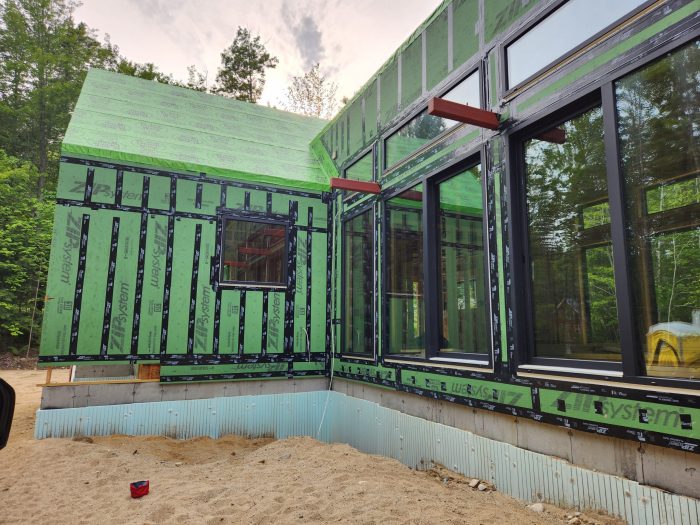 |
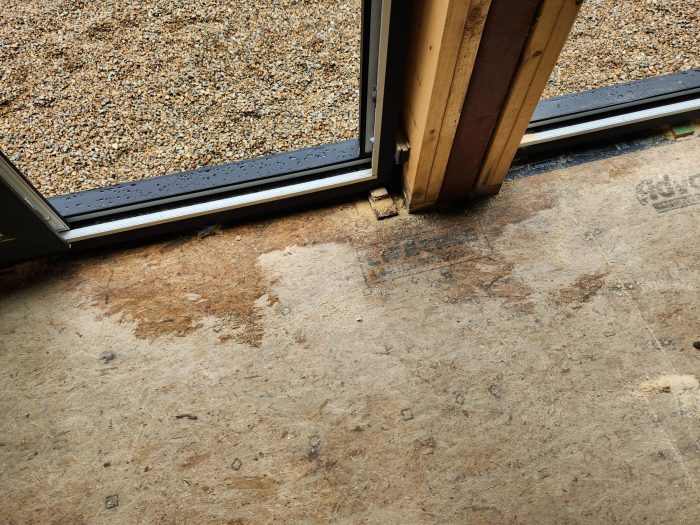 |
I have a few installation details I’m concerned with at this stage, and I’m worried about adding insulation. There is water getting into the assembly in various locations, so much so that the subfloor and some bottom plates and lower studs appear saturated (it seems to dry out between storms). There are fish mouths in the ZIP tape installation that are gathering water (I can press on some taped areas and water shoots out). Also, one side of the roof has Protecto Wrap installed horizontally (shingled), and the other side has it installed vertically, overlapped. Why would anyone do that?
How concerned should I be at this stage? The steel roof and siding will obviously be the main layer of defense again the weather, but how “resistant” should the WRB actually be? Add the complication of the “zero overhang” design of the roof to siding detail, and water becomes a real problem. Should I make them re-tape and re-roll everything (again)? Should they add a separate WRB on top?
Thanks,
Jim
Related Links:
Question 2: Should I seal the bottom of my flanged windows?
Mike on GBA writes:
I have a crew about to put in 32K worth of new windows. I spoke with the Andersen window rep for my area about the installation plan, and considering I’m using Prosoco WRB products (liquid flashing) for the entire house, he was okay with sealing the entire perimeter including the bottom of the window.
I understand the logic of providing an escape path in the event of a failure, but considering the windows are warrantied for a decade, I’m leaning toward sealing them up so that I see the water damaging the drywall returns and know I have a window that’s compromised. What do you think?
Related Links:
- Part 4: Air-Seal and Insulate a Nail-Fin Window over a Fluid-Applied WRB
- Airtight Window Installations
- A Weatherproof Window Installation
Question 3: Is kickout flashing the best choice around bay windows?
All_thumbs in the Discussion Forum writes:
I had the roof replaced on my house last year and the roofers did a fine job, except for the roofing on the bay windows, where the roofers removed some clapboard and tucked the roofing up under it and then re-attached the clapboards. The clapboards in this part of the house are not in great shape (see photo), and then there’s the caulk the roofers used to fill in their nail holes. My fall project is to replace the clapboards and make sure the entire area is well-flashed.
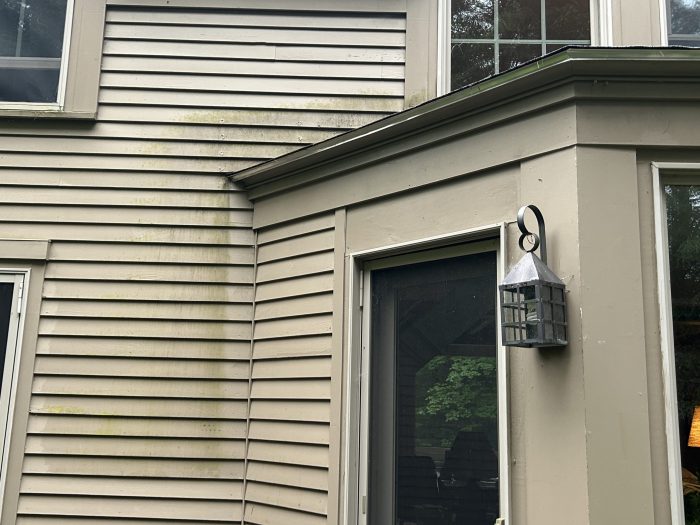 |
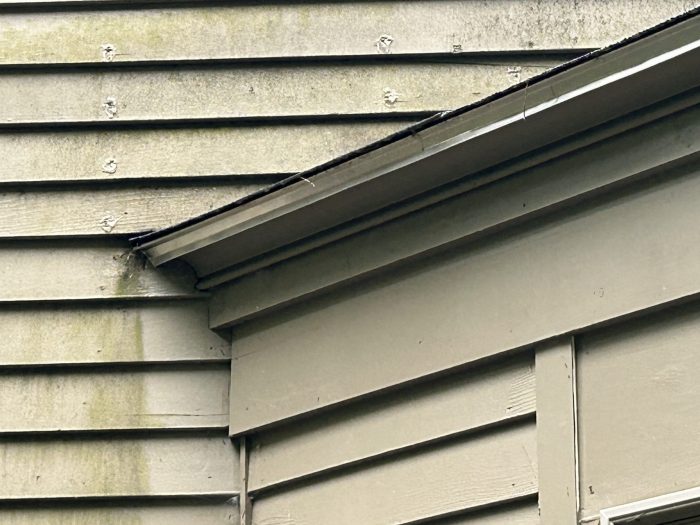 |
Should I install kickout flashing where the roof meets the side of the house, and, if so, should I go with metal or plastic? The roof on the bay windows does not have a good pitch for drainage–I live in Maine–but the windows above will not allow for much slope in this area (and would also be against code, according to the roofer), so I want to flash it as aggressively as possible. Any advice on kickout flashing for this spot (identical on either side) would be helpful. Thanks
Related Links:
- Weatherizing a Boxed-Bay Window
- Bay-Window-Roof: Final Installation
- Don’t Forget the Flashing
- Kickout Flashing for Seamless Siding and Trim
Question 4: What are the best options for EV charging?
Patrick asks:
I’m considering an EV and was wondering what it costs to get a level 2 or 3 charging system for home. Is one manufacturer better than another? Have y’all considered a feature on home EV charging?
Related Links:
- Power Your Home with Bidirectional Chargers
- Fast, Flexible Car Charger
- Smart and Agnostic Electrical Panel
END NOTE:
Podcast 597: Members-only Aftershow — Mike’s Not-so-Forever Home
Mike Guertin talks about some less-successful building products and design choices he made when building his first forever house.
This episode of The Fine Homebuilding Podcast is brought to you by Loctite’s Pro Foam

The Gaps & Cracks and Window & Door items seal and insulate gaps and fit any standard foam gun applicator. Loctite’s Fire Block Pro Foam fills gaps while resisting the migration of fire and smoke. Perfect for electrical, plumbing, and wherever a fire-resistant foam is needed. Say yes to Loctite’s new Pro Foams. Say yes to Loctite.
Visit Loctiteproducts.com for more information.
Check out one of our latest Project Guides: Energy Retrofit!
Check out our FHB Houses:
Visit the Taunton Store • Magazine Index • Online Archive • Our First Issues • All Access

If you have any questions you would like us to dig into for a future show, shoot an email our way: [email protected].
If we use your question we’ll send you a FHB Podcast sticker!
FHB Podcast T-shirts!
Represent your favorite podcast! Available in several styles and colors. Made from 100% cotton. Find the Podcast t-shirt and more cool products in the Fine Homebuilding Store.
| Fine Homebuilding podcast listeners can now get 20% off anything in the Taunton store, including Pretty Good House.
Use the discount code FHBPODCAST to take advantage of this special offer. |
 |
“Finally, knowledgeable people talking about building reasonably-sized, high-performance houses for normal people with real budgets!” — DanD, VA, 8/19/22, Amazon.com review |
We hope you will take advantage of a great offer for our podcast listeners: A special 20% off the discounted rate to subscribe to the Fine Homebuilding print magazine. That link goes to finehomebuilding.com/podoffer.
The show is driven by our listeners, so please subscribe and rate us on iTunes or Google Play, and if you have any questions you would like us to dig into for a future show, shoot an email our way: [email protected]. Also, be sure to follow Fine Homebuilding on Instagram, and “like” us on Facebook. Note that you can watch the show above, or on YouTube at the Fine Homebuilding YouTube Channel.
The Fine Homebuilding Podcast embodies Fine Homebuilding magazine’s commitment to the preservation of craftsmanship and the advancement of home performance in residential construction. The show is an informal but vigorous conversation about the techniques and principles that allow listeners to master their design and building challenges.
Other related links
-
- All FHB podcast show notes: FineHomebuilding.com/podcast.
- #KeepCraftAlive T-shirts and hats support scholarships for building trades students. So order some gear at KeepCraftAlive.org.
- The direct link to the online store is here.
